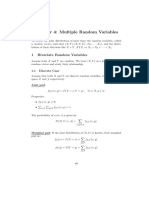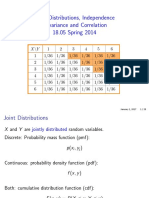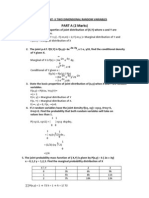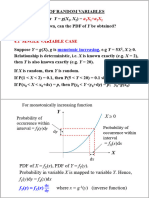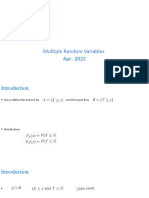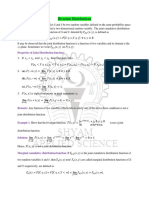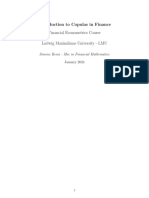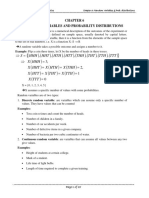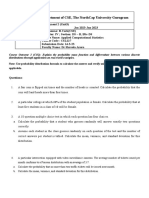4.1.
3 Conditional Distributions
P( A B)
We already know that if P A 0, then P B | A ……………………………..(1)
P( A)
If X and Y are discrete random variables and we have the events
{A: X=x}, {B: Y=y}, then equation (1) above becomes
P ( X x, Y y ) f ( x, y )
P (Y y | X x )
P( X x) f1 ( x)
Where f ( x, y ) P ( X x, Y y ) is the joint probability function and f1 ( x) is the
f ( x, y )
marginal probability function for X. we define f ( y | x) and call it the
f1 ( x)
conditional probability of Y given X. Similarly, the conditional probability of X
f ( x, y )
given Y is f ( x | y ) . We sometimes denote f ( x | y ) and f ( y | x) by f1 ( x | y )
f2 ( y)
and f 2 ( y | x) respectively. If X and Y are continuous random variables, then the
f ( x, y )
conditional density function of Y given X is f ( y | x) where f ( x, y ) is the
f1 ( x)
joint density function of X and Y and f1 ( x) is the marginal density function of X.
Thus we can find, for example, that the probability of Y being between c and d
given that x X x x as
d
P(c Y d | x X x x) f ( y | x)dy .
c
1
�Example 4
The joint probability function of two discrete random variables X and Y is given
by
1
2x y x 0,1, 2; y 0,1, 2,3
f ( x, y ) 42
0 Otherwise
Find
a) f(y|2)
b) p(Y=1|x=2)
Solution.
f ( x, y ) p (Y y , x 2)
a) f ( y | 2)
f1 ( x) p ( x 2)
3 3
But f1 ( x) f ( x, y) p(Y y, X 2)
y 0 y 0
3
1
= (4 y ) =1/42(4+5+6+7) = 22/42 = 11/21.
y 0 42
1
f ( x, y ) P( x 2, Y y ) (4 y )
42
1 4 y
Hence f ( y | 2) 42 =1/22 (4+y)
11
21
b) p(Y=1|x=2) = 1/22(4+1) = 5/22
2
�Example 5
If X and Y have a joint density function
3
xy 0<x 1; 0<y 1
f ( x, y ) 4
0 Otherwise
Find
a) f ( y | x)
1 1 1
b) P Y | X dx
2 2 2
Solution.
a) For 0 <x<1
3
1 1
3 x
f1 ( x) f ( x, y )dy xy dy
0
0
4 4 2
3 xy 3 4 xy
f ( x, y ) 4 , 0 y 1
Hence f ( y | x) 3 x 3 2x
f1 ( x) 4 2
0, other y
For other values x , f ( y | x) is not defined.
3 2y
1
9
b) P Y 1 2 | 1 2 x 1 2 dx f y | 1 2 dy dy
1 1 4 16
2 2
3
�4.1.4 Variance for Joint Distributions (Co-Variance)
Let X and Y be two continuous random variables having joint density function
f(x, y). Then the means or expectations of X and Y are given by:
X E X xf ( x, y )dxdy,
Y E Y yf ( x, y)dxdy.
And the variances are given by
X2 E X x x
2 2
f ( x, y )dxdy,
X
Y2 E X Y y
2 2
f ( x, y )dxdy.
Y
Another parameter that arises in the case of two variables X and Y is called the
covariance defined by
XY Cov( X ,Y ) E X X Y Y
In terms of the joint density function f(x,y), we have
XY x y f ( x, y)dxdy
X Y
If X and Y are discrete, then we write
X xf ( x, y )
x y
4
�Y yf ( x, y )
x y
XY x X y Y f ( x, y )
x y
Where the sums are taken over the discrete values of X and Y.
The following theorems are very important in covariance.
1. XY E ( XY ) E ( X ) E (Y ) E ( XY ) X Y
2. If X and Y are independent random variables, then XY Cov( X , Y ) 0 . The
converse of this in not necessarily true.
3. Var ( X Y ) Var ( X ) Var (Y ) 2Cov( X , Y ) i.e. X2 Y X2 Y2 2 XY . If X and Y
are independent, this reduces to Var ( X Y ) Var ( X ) Var (Y ) i.e.
X2 Y X2 Y2 In other words, the variance of a sum of independent
variables equals to the sum of their variances.
4. XY X Y
5
� 4.2 INDEPENDENCE OF RANDOM VARIABLES
Suppose that X and Y are discrete random variables. If the events X=x and Y=y
are independent events for all x and y then we say that X and Y are independent
random variables. In such case P(X=x, Y=y) = P(X=x) P(Y=y) or equivalently,
f(x, y)= f1(x) f2(y). Conversely, if for all x and y the joint probability function f(x, y)
can be expressed as a product of a function of x alone and a function of y alone
(which are then the marginal probability functions of x and y), then X and Y are
said to be independent. If X and Y are continuous random variables, we say that
they are independent random variables if the events X ≤ x and Y ≤ y are
independent events for all x and y. In such a case we write
P(X ≤ x, Y ≤ y) = P(X ≤ x) P(Y ≤ y) or equivalently, F(x, y)= F1(x) F2(y) where F1(x)
and F2(y) are the marginal distribution functions of X and Y respectively.
Conversely, X and Y are independent random variables if for all x and y their
joint distribution F(x, y) can be expressed as a product of a function of x alone,
f1(x), and a function of y alone, f2(y), and these are the marginal density functions
of X and Y respectively.
Example 1
Show that the random variables X and Y whose joint probability distribution
function is
1
2x y x 0,1, 2; y 0,1, 2,3
f ( x, y ) 42
0 Otherwise
6
�are not independent (i.e. are dependent)
Solution
3
f1 ( x) f ( x, y )
y 0
1
7 x0
f1 (0) x0
1
f1 (1) x 1 x 1
f (2) x2 3
1 11
21 x2
2
Similarly, f 2 ( y ) f ( x, y )
x 0
f 2 (0) y0
f (1) y 1
2
f 2 (2) y2
f 2 (3) y 3
1
7 y0
3 y 1
4
2 y2
7
5
y3
4
Now consider P(x=0, y=0) = P(X=0) P(Y=0)
=1/7 × 1/7 = 1/49
7
�But P(X=0, Y=0) = 1/42 (0+0) = 0.
⇒ P(X=0, Y=0) ≠ P(x=0, y=0)
Or consider
P(x=1, y=2) = P(X=1) P(Y=2)
= 1/3 × ¾ =1/4
But P(X=1) P(Y=2) = 1/42 (2+2) =2/21.
⇒ P(X=1, Y=2) ≠ P(x=1, y=2) .
And so on!
Thus 1/42 (2x + y ) cannot be expressed as a function of x alone times a function
of y alone. Hence X and Y are dependent.












